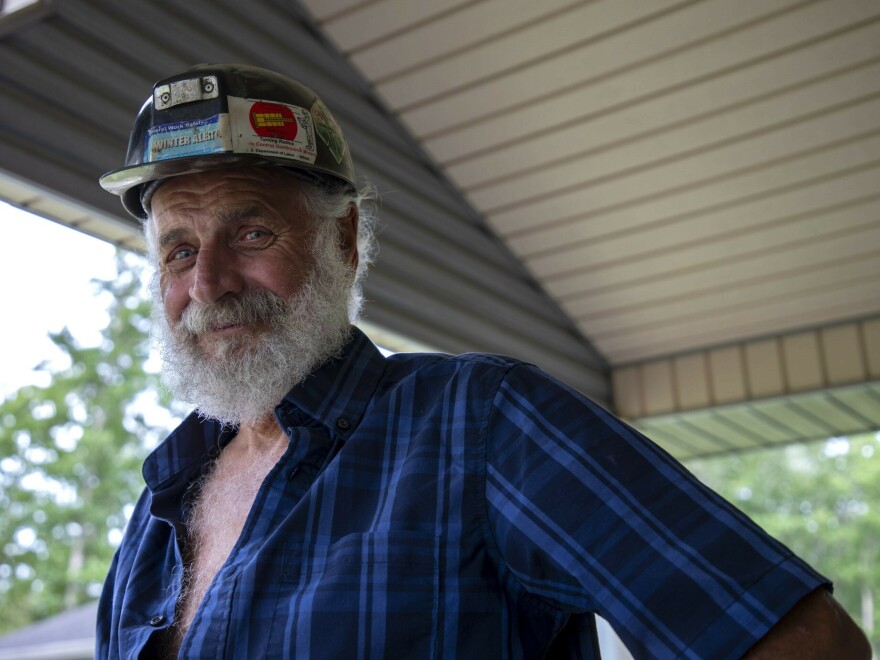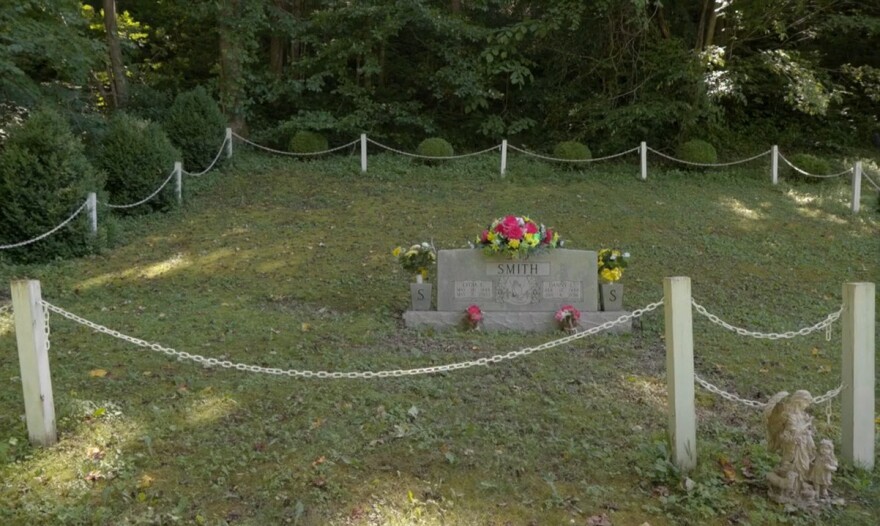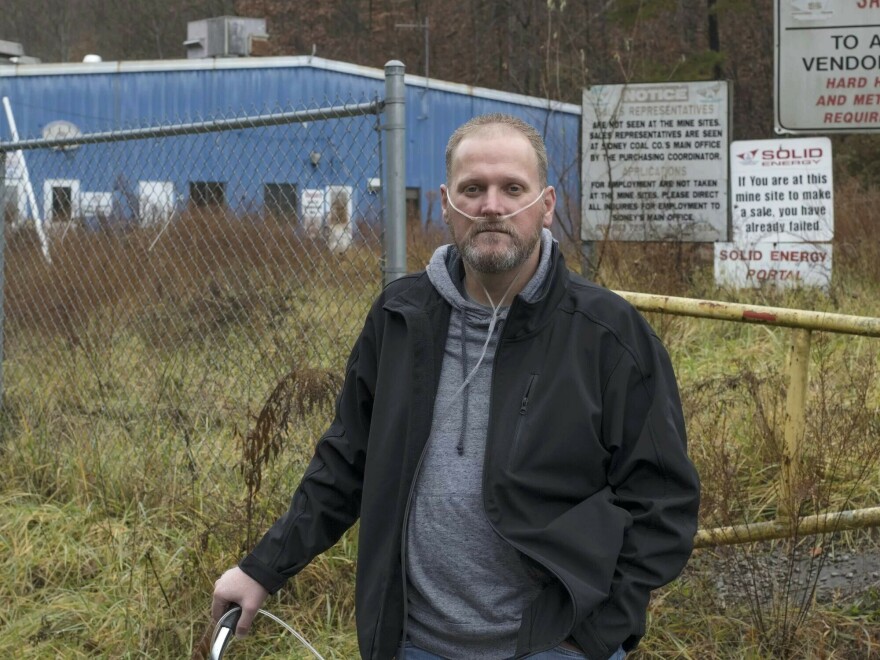Updated November 19, 2023 at 8:30 AM ET
The gravesite in Danny Smith's vast and verdant yard is shaded by hulking trees. His parents' graves are adjacent and marked by a massive headstone. In summer, crickets chirp, birds sing, and leaves rustle in the breeze.
It is a peaceful spot for Smith's final resting place. And it's ready.
"I honestly never imagined it would get this bad," Smith, 51, wrote in a text message from his home in the coalfields of eastern Kentucky. His breathing is so labored at times, he wrote, that he wasn't sure he could get through a phone call.
"I have a hard time just walking to the kitchen without losing breath," he wrote. "I stay so tired and exhausted."
Smith's lungs are riddled with fibrotic tissue. When NPR and PBS's Frontline last visited in 2018, he tried to mow his lawn, but a fit of heavy hacking forced him to his knees. Coughing violently, he spit out what looked like moist and crusty bits of dark gray paper with black streaks — dead lung tissue, his respiratory therapist told us.
Smith suffers from progressive massive fibrosis, or complicated black lung, an advanced, incurable and fatal stage of black lung disease. It's caused by the inhalation of coal mine dust, especially exposure to highly dangerous silica dust.
Silica is one of Earth's most abundant minerals, and it's about 20 times more toxic than coal dust. It's typical in the quartz that surrounds coal seams, especially in central Appalachia. Mining machines cut through the rock to reach and to mine coal seams, grinding rock into fine, sharp and easily inhaled silica particles.
Exposure to silica dust likely explains Smith's complicated black lung diagnosis at the relatively young age of 39 and after just 12 years of cutting rock and coal underground.
"As bad as I feel now, and I never thought I would say it," Smith texted, "I so wish I had never stepped foot inside a mine."

The scale of a profound human tragedy
Concern over silica's role in black lung has been growing for decades, and mine safety advocates have urged regulators to act since 1974. And this summer, the federal Mine Safety and Health Administration (MSHA) finally issued a proposed new regulation to limit miners' silica dust exposure.
The draft rule would establish a silica dust exposure limit twice as tough as it is now. It also creates a framework for the agency to directly regulate excessive silica exposures, something it hasn't previously done, making citations and fines possible for putting miners at risk.
"Our current standard as it relates to regulating silica in the nation's mines ... does not adequately protect miners' health," said Christopher Williamson, assistant secretary of labor for mine safety and health.
Mine safety advocates welcome the new exposure limit — 50 micrograms of silica per cubic meter of dust. It's what they've been seeking for decades.
But if the rule is adopted, the agency predicts it would save only 63 coal miner lives and avoid 244 cases of black lung disease over 60 years. An investigation by Public Health Watch, NPR, Louisville Public Media and Mountain State Spotlight suggests this may be a gross underestimate of the rule's potential upside.
The investigation sought to document a more complete picture of the current prevalence of the disease than previously reported. It found more than 4,000 cases of complicated black lung since 2010 and more than 1,500 diagnoses in just the last five years alone.
The agency's failure to account for the thousands of sick and dying miners now suffering from the disease seems to undercut the urgency for a proposed regulation that mine safety advocates consider essential to saving lives.
"The scale of human tragedy is profound," said Kirsten Almberg, an epidemiologist at the Black Lung Data and Resource Center at the University of Illinois Chicago. "There's really no way to quantify ... the individual tragedy that happens in each of these cases, with lives cut short, careers cut short, communities reeling and families falling apart. It's just devastating."
When comparing the actual count of complicated black lung cases documented in this investigation with MSHA's predictions, "the difference in scale is striking," said Almberg.
Mine safety advocates are concerned that failing to make the strongest case for the proposed rule could embolden opposition from the mining industry and its supporters in Congress. In fact, a House Republican has already launched an effort to block spending to implement the new silica dust regulation, even though the mine safety agency has yet to issue a final version of the proposal.
Miner advocates are also concerned that the proposed rule's enforcement provisions are weak, its reach is too expansive and that it could still ultimately fail to protect miners from silica's noxious effects.
So many miners dead and dying
The mine safety agency's predicted number of cases that could be avoided with stricter regulation pales in comparison to what black lung clinics are actually seeing.
Three clinics alone in southwestern Virginia and eastern Kentucky have together reported more than 1,500 cases in the last decade. That's six times the number of cases MSHA says its proposed rule would prevent over 60 years.

"As of now, we are almost at 700 cases of complicated black lung," said Dr. Brandon Crum, a radiologist specializing in black lung X-ray assessments at United Medical Group in Pikeville, Ky.
"I'm surprised that we continue to see that much disease and the severity of the disease," Crum added. "We're seeing younger and younger miners get it. ... Men in their 30s, 40s and 50s on a regular basis."
Two clinics operated by Stone Mountain Health Services in southwestern Virginia report more than 800 cases of complicated black lung in the last decade.
That has pulmonologist Drew Harris, Stone Mountain's medical director, questioning MSHA's disease predictions. "Not factoring into their risk prediction the amount of disease that is currently happening and had been happening for 10 to 15 years ... is not acceptable," Harris said.
A pair of respiratory therapy clinics in southwest Virginia and eastern Kentucky also have caseloads that defy MSHA's projections for avoided disease and death.
"We lost 11 men in the last seven months ... 147 deaths have occurred in my clinics, from black lung, in 10 years. And that is heartbreaking," said Marcy Martinez, a respiratory therapist who operates New Beginnings Pulmonary Rehab, which specializes in therapy for miners with complicated black lung.
"I don't think they have a concept of what the reality is out there...," Martinez added.

The mine safety agency responds
Almberg, at the University of Illinois Chicago, said she understands how the agency came up with relatively small numbers for deaths and cases of disease that could be avoided with its proposed silica dust rule.
She explained that the agency's predictions were based on a risk analysis that depends on knowing precisely how much silica dust exposure sick miners experienced. That detail is not available for the thousands of cases reported by the clinics and NIOSH.
"They're not really able to use that in the modeling because we're not able to quantify exposure," Almberg said.
"I do think it is an underestimate," Almberg added. The agency said so in its proposal, she noted, though there still was no mention anywhere else of the thousands of documented cases of disease in the last decade.
The mine safety agency at first deferred questions about its risk analysis, and other concerns about the proposed rule, until after a public comment period ended Sept. 11.
A few weeks later, MSHA responded directly to Public Health Watch, saying it is considering suggestions that it "underestimates the benefit of the proposed [silica dust limit] as the agency works toward a final rule."
The statement also noted that Assistant Secretary Williamson attended a recent national conference of black lung clinics and received updates from clinic staff, health experts, black lung researchers and sick coal miners.
"Williamson is deeply troubled by the amount of disease — including the most advanced forms — that health experts continue to report in Appalachia," the agency said.
MSHA has yet to announce a timeline for a final rule, but given required reviews and approvals from the Labor Department and the Office of Management and Budget, the final language could be months away.

A history of overexposures to toxic dust
The proposed crackdown on silica follows a fraught history of the mine safety agency's decades of failure to protect miners from the toxic dust. The proposal also overlooks a history of overexposure at coal mines.
Again, this downplays the need and justification for action.
The rule notes that 93% of silica dust samples have been in compliance with existing silica dust limits since 2016. But the remaining 7% of samples amount to 5,300 instances of excessive exposure to the dust based on the newly proposed limit, according to MSHA data analyzed by Louisville Public Media and Public Health Watch.
In the 30 years leading up to 2016, agency data analyzed by NPR and Frontline found 21,000 excessive silica dust samples based on the existing limit. More than twice that many dust samples — 52,000 — exceeded the newly proposed limit.
This means that coal miners worked amid dangerous levels of silica dust — which is easily inhaled, easily lodges in lungs and can lead to severe disease and death — tens of thousands of times in 30 years.
During those three decades, the risk of silica dust exposure increased, as mining consumed the thickest coal seams, leaving thinner seams embedded in rock. Cutting those thinner seams generated more fine silica particles.
Also, during that period, the agency did not respond effectively to the threat.
As far back as 1996, internal agency memos obtained by NPR acknowledged the problem, including a cluster of severe black lung disease linked to silica dust exposure. The agency sent out warnings to mining companies about the threat and suggested voluntary action to reduce exposure.
It also has since conducted coal and silica dust enforcement campaigns, staging special unannounced inspections at mines persistently exposing miners to excessive dust.
But no action was taken to specifically regulate silica dust, until now.
The dust devil in the details: Are proposed protections tough enough?
Mine safety advocates credit the agency for proposing two monumental changes: making the silica dust exposure limit twice as strict and directly regulating silica dust for the first time.
But there's a dust devil in the details. Miner advocates complain about elements of the proposal that seem to permit self-policing by mining companies and render agency oversight and enforcement weak, ineffective or nonexistent. Here are their main concerns — and what they think could be improved:

1) Sampling is in the hands of the mining companies — more oversight is needed
The proposed rule requires mining companies to sample coal mines for silica dust when and where miners are working. The samples will then be sent to independent labs for analysis.
If the samples show excessive silica, mining companies will be required to reduce the exposure, using what are called engineering controls: increasing ventilation to sweep away dust; making sure water sprays are working properly and tamping down dust; slowing down mining machines to diminish dust; and/0r deciding not to cut thinner coal seams embedded in the rock that produces dust.
These corrective actions and the silica dust sampling are left completely to mining companies. They're required to keep records of the samples and their responses, but they are not required to send those records to MSHA.
Federal law is "very clear that the ultimate responsibility for miners' safety and health lies with the mine operator," said Williamson, the mine safety chief.
"Operators have legal obligations and you start out from the premise that people are going to comply with the law. ... And then if they don't, there are consequences for that."
In fact, there's a history of dust sampling fraud, with a Kentucky company fined and an employee sentenced to prison this year, and convictions in another case last year.
The proposed rule also fails to describe MSHA's oversight and enforcement of mining company sampling, and responses to dangerous levels of dust.
The agency responded by saying it will continue its existing oversight and enforcement routine: quarterly inspections required by federal law, which include MSHA's own silica dust sampling and analysis. Agency inspectors can ask to see mining company records of dust sampling and corrective actions.
But inspectors are in coal mines only a fraction of the time. They won't witness most of the sampling conducted by mine operators and most of the changes companies make to control excessive dust.
"Without enforcement of the rule ... it's essentially useless," said Drew Harris of the Stone Mountain clinics. "If people don't follow the rule or there's no incentive to follow the rule, it's not going to have effect. And I'm not convinced that as it is written there's enough incentive to do the right thing."
West Virginia coal miner Cecil Matney Jr. is more direct, based on his 25 years of mining experience.
"If you're not holding the company responsible for something, they're gonna break that rule," he said.

MSHA added in its recent statement to Public Health Watch and its reporting partners that it is considering more direct oversight and enforcement, at least when it comes to excessive dust detected in mining company samples.
"MSHA is considering requiring that when an operator's sample is above the [silica dust limit] that operator reports that overexposure to the MSHA district manager," the agency wrote.
"This would allow MSHA to take appropriate enforcement action and provide any necessary compliance assistance to operators."
2) It takes too long to analyze dust samples — quicker technology is available
It now takes a week or more for silica dust samples to reach labs and undergo analysis, and for mines to get back results. That means excessive exposures could continue, shift after shift, while mines await results.
A new sampling process gets results much quicker — right at the end of every sampled shift. That makes possible an immediate response to excessive dust.
Some mining companies are using the new sampling process voluntarily, but MSHA doesn't require its use because it is not considered reliable enough for compliance and enforcement.
NIOSH developed the new process, and in an emailed statement the federal research agency said, "the accuracy of the approach, in its current state, can be affected by the presence of other components in the dust."
Still, some mine safety advocates consider it "the best available technology," a phrase from federal law that they argue permits required use of the device, even if it's not fully refined.
The device "would facilitate more frequent sampling and far more rapid correction of hazardous conditions," wrote Richard Miller in his comments on the silica dust proposal. Miller is a retired labor policy director for the House Committee on Education and Labor.
"It is well within MSHA's authority, based on the legislative history of the Mine Act, to issue a technology-forcing standard that requires operators to use best available technology — including technology that is off-the-shelf or on-the-horizon," Miller wrote.
MSHA has not responded to Miller's claim.
3) Continuing to work is required even when dangerous dust is detected. Miners should be kept away from dirty air
The proposed rule permits work in dangerous levels of dust "temporarily" while mine operators take corrective action to get dust down to the legal limit. In these circumstances, miners would be required to wear protective dust masks or respirators.
The mining industry has argued for decades that miners could work safely in excessive levels of dust as long as they wear protective gear.
The National Mining Association said in its comments on the proposal "that supplemental controls [masks and respirators] are necessary to protect health" and that relying exclusively on engineering controls, like robust ventilation or slowing down mining machines, hasn't prevented disease and death.

But many miners complain that the dust masks and respirators they've been given are often ineffective and even counterproductive.
"You put them over your face ... and you're gasping for air all the time," said Danny Johnson, a 69-year-old retired coal miner with 37 years in coal mines and a case of complicated black lung now.
The masks also get hot, he added. "You burn up. I mean, you burn up constantly."
Miners have filed hundreds of lawsuits over the ineffectiveness of dust masks. Some have resulted in multimillion-dollar verdicts and settlements.
More-modern respirators are considered effective in keeping out dust. But some miners complain they can partially block vision and/or impair hearing, which are critical while doing hard and perilous work that requires clear sightlines and communication.
"How long are you going to tell a miner to rely on the respirator to continue working in a toxic environment recognizing that it's not totally feasible for miners to rely on respirators continuously underground?" asked Harris of the Stone Mountain clinics.
Harris and others want further work prohibited until the mine atmosphere is cleared of dangerous levels of dust. This approach is a fundamental principle of workplace safety, called the hierarchy of controls, which puts elimination of hazards as the first "preferred" action, and use of personal protective protective equipment, like dust masks and respirators, as the last.
The mine safety agency responds to this concern and others by saying they will be considered while developing a final rule.

4) Protection is expanded to all mines, not just coal — a daunting regulatory task
The proposed rule doesn't just apply to the nation's 930 coal mines. It also applies to 11,000 other mines, collectively known as metal/nonmetal mines, which employ 144,000 more miners than coal mines. They, for the first time, will be required to sample for silica dust, and to provide miners with medical screening for disease.
This is a massive new regulatory requirement for the mines and the agency that regulates them. It requires an extensive dust sampling and medical surveillance infrastructure that does not currently exist.
"An identical approach will not work for coal and [metal/nonmetal] in all circumstances," said the National Mining Association in its response to the proposal. "An attempt to create a uniform approach will complicate sampling efforts and frustrate [the agency's] desired goal of a smooth and rapid adoption of this crucial initiative."
Some safety advocates worry that including metal/nonmetal mines in the proposal will make it more difficult for MSHA to fully protect coal miners, who are already suffering by the thousands.
"Protections for coal workers ... are just at a crisis level and need to be prioritized," said Harris of the Stone Mountain clinics, though he acknowledges the importance of protecting metal/nonmetal workers as well.
Mine safety chief Williamson pushed back, saying the agency "has responsibilities to protect all miners' safety and health."
Williamson provided a highlighted copy of the agency's fiscal year 2024 budget request, which seeks an increase of more than $20 million for expanded enforcement: $7 million is specifically for silica dust enforcement, and more than $2 million would increase the capacity of MSHA's labs to accommodate an expected escalation in dust samples collected by agency inspectors.
"We've demonstrated that this is a priority. And we've asked for more money to be able to do it," Williamson said.
The budget request has the support of the White House but still must be approved by Congress. The House Appropriations Committee has already proposed cutting the agency's requested budget by nearly $63 million.
The urgency to act: "Am I going to see my kids grow up?"
In Logan County, West Virginia, coal miner Cecil Matney Jr. doesn't want to see younger miners end up like him. "Am I going to get to see my kids grow up?" he asked. "That's something you don't know."
Matney is just 50 but already has a diagnosis of complicated black lung.
"It feels like a ton of bricks laying on your chest when you're trying to catch your breath," he said. "My wife's woken me up thinking I was dying because I wasn't breathing."
Matney still works under a special federal program that keeps him in mining but in jobs away from dangerous dust.
Despite coal plant and mine shutdowns that cost more than 50,000 other miners their jobs since 2011, some 40,000 coal miners still work in U.S. mines.
Foreign demand for American coal continues, especially for high-value metallurgical coal used to make steel. "Met" coal, as it's called, is so valuable that mining companies will cut thinner and thinner seams, and more and more silica-bearing rock, to retrieve it.
More than 12,000 miners worked in metallurgical mines last year, according to the Energy Information Administration.
Thousands of miners will likely continue to mine coal for years to come and will continue to face exposure to silica dust.
"We don't have as many miners as we used to, say 20 years ago," said radiologist Crum, "but I think the percentage of miners that are going to contract black lung will probably be higher, and the percentage of severe disease will be significantly higher."

Back in eastern Kentucky, Danny Smith typed out more messages on his cellphone, an oxygen tube clipped to his nostrils. He's on oxygen all the time now, he wrote. He can't get enough air without it and he's being assessed for a double-lung transplant.
"I totally agree that something has to be done," Smith wrote, happy to see that MSHA plans to do more to protect miners from the silica dust that made his life so difficult at such a young age.
He's also wistful about what he calls the "billion-dollar coal fields" in his corner of Appalachia and the prosperity mining jobs made possible.
"Coal mining made it what it was at one time," he said. "People had very comfortable lives here."
There was a pause in his typing. Then these words slowly appeared:
"I would rather be poor and [have] no home as to feel what I've been feeling lately and knowing it will only get worse."
This story comes from Public Health Watch and was produced in partnership with Louisville Public Media and Mountain State Spotlight. An earlier version of this story ran on Aug. 31 on Public Health Watch and partner sites. This version of the story has been updated with additional reporting.
Public Health Watch is an independent nonprofit investigative newsroom focused on public, environmental and occupational health.
Howard Berkes is a retired NPR investigations correspondent who collaborated with the PBS series Frontline on a landmark 2018 investigation exposing an epidemic of complicated black lung disease and the failure of federal regulators to prevent it.
Justin Hicks is the data reporter for Louisville Public Media and the Kentucky Center for Investigative Reporting.
Allen Siegler is the public health reporter for Mountain State Spotlight, an independent investigative reporting news service focused on West Virginia.
Carmel Wroth edited this story for NPR.
Copyright 2023 NPR. To see more, visit https://www.npr.org.



